


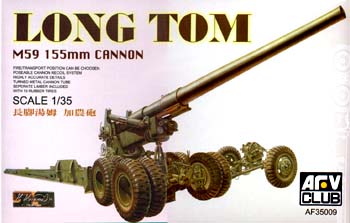 AFV CLUB
1/35 M59 CANNON 'LONG TOM'
AFV CLUB
1/35 M59 CANNON 'LONG TOM'
KIT NO. 35009
By Ray Mehlberger
MSRP: $32.00
HISTORY
To increase divisional fire-power, the U.S. Army began research on a long range cannon in 1920 in the hope of installing a 155mm and a 203mm howitzer on one chassis. This was to simplify the production process and to decrease maintenance cost. The new weapon was produced in 1938 and was named the M-1. In 1941 the 155mm cannon was renamed the M-59, and the 203mm was renamed the M-115 to avoid any more confusion between the two.
The M-59 is 7.036 meters long, with a maximum firing range of 25,000 yards (22850 meters). The chassis is supported by twin hydrolic balance arms. The main fire control system includes a M16A1F elbow-sight and a M12A7C round-sight. When in use, the chassis of the M-59 must be lowered and steadied by an anchor and will be able to move from an upward angle of 60.30 degrees to a downward angle of 1.50 degrees. The towed M-59 chassis is installed on a eight-wheeled bogie plus a two-wheeled trailer and is operated by a 14 member gun crew. At the end of WWII, the M-1 carriage was installed on a M4A3 'Sherman' tank hull, to increase it's mobility, and was named the M-40 self-propelled gun.
The M-59 cannon has been in use in countries like the U.S., R.O.C., Japan, Austria, Argentina, Denmark, Greece, Italy, South Korea, Jordan, Pakistan, Turkey, Czechoslovakia, etc.
The Kit
 |
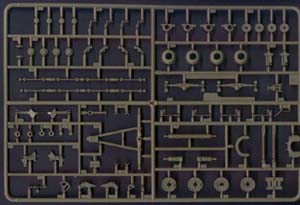 |
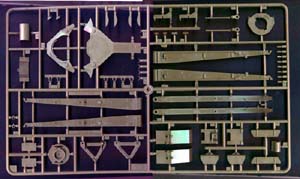 |
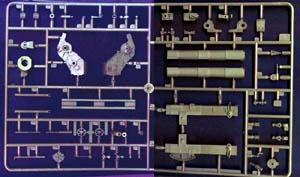 |
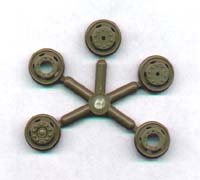 |
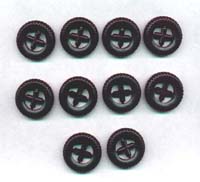 |
AFV Club originally released this kit in 1994 (I believe). At first, knowing that AFV Club's armor kits were mostly of modern stuff (and I am a WWII nut), I avoided this kit. A fellow on the internet insisted that it was WWII - so I finally broke down and bought it at the local shop. Although it is not a brand new kit, it is new to me - and - I thought some of the readership as well.
The 'Long Tom' model comes in a rather large box. At 15"x9" the box top would not all fit on my scanner , so I could do the box art. I had to do it in two pieces.
The box art is a very detailed drawing of the cannon in the firing position on a stark white background. Three pictures, of the assembled model, adorn the side panel of the box. Upon opening the box, one notices that this kit is no 'box rattler' and is chock full. Uniquely, the inside of the lid and tray to this box is festooned with miniature reproductions of the box arts of other kits that AFV Club markets. Its like having their catalog. Neat idea!!
Each of the large medium green, plastic parts trees have their own separate cello bags. One other small cello holds the ten wheel hubs and a second small cello holds ten vinyl tires.
A turned aluminum gun barrel is the icing on the cake in this kit. I hate trying to eliminate the seams on those two-piece plastic ones and attempting to keep everything round in profile - sometimes that is a real bear!
The first large tree of parts holds 61 parts that are mostly for the base and trail pieces and associated hardware for the cannon. A second, similar sized, tree holds 54 more parts for the gun cradle, trunions, elevation wheels, etc A third, slightly smaller, tree holds 84 small parts of various fittings.
There is, sadly, no gun crew figures or any ammunition provided. However, AFV Club does market the ammo in a separate kit. I intend to get this later.
A 12 page instruction book is included for assembly of the cannon. No decals are in the kit, but I doubt this cannon ever featured any markings at all.
The cannon can be built in either the towed, or the firing position. The amount of recoil of the barrel can be posed to suit also.
The first page of the 12 page instruction booklet gives the history of the weapon, in Chinese, Japanese, and English. Page 2 is assembly tips, international symbol explanations, and color numbers for Tamiya and Gunze Sangyo paints. Pages 3 through 11 give 14 steps of assembly. A line drawing on page 12 shows the cannon in firing position and another two drawings are above and side views showing the cannon in its towed position.
The paint scheme given would be a real easy one. It shows overall Olive Drab with black tires and a area of the bright metal on the elevation arms.
This cannon will make up really large. The molding is real high quality, with no flash evident and only a few mold ejector marks to attend to.
Conclusion
I highly recommend this kit to any armor builder who has a liking of field pieces. The only reservation I have about the kit is the lack of a gun crew.

Previous: Contents







